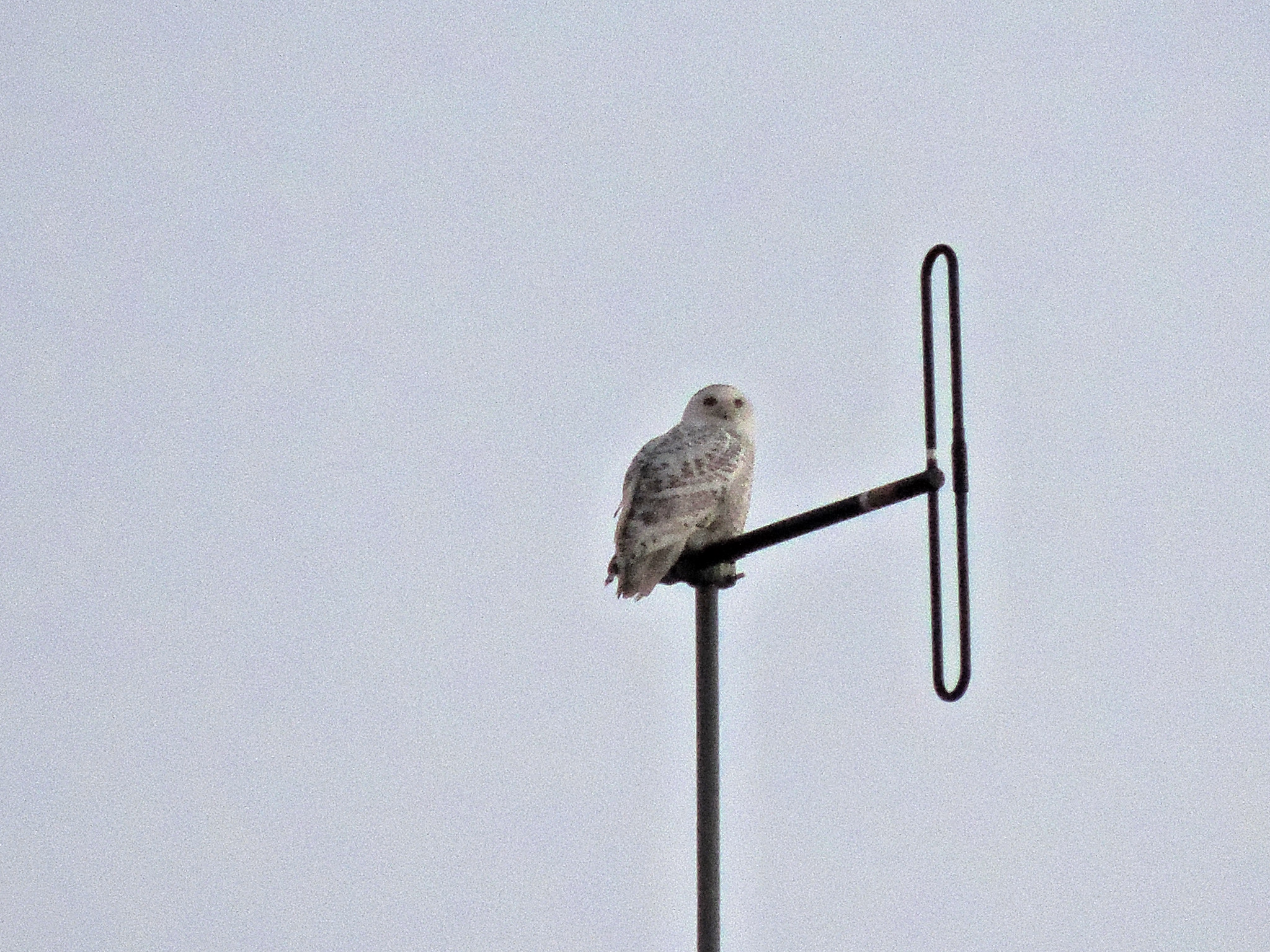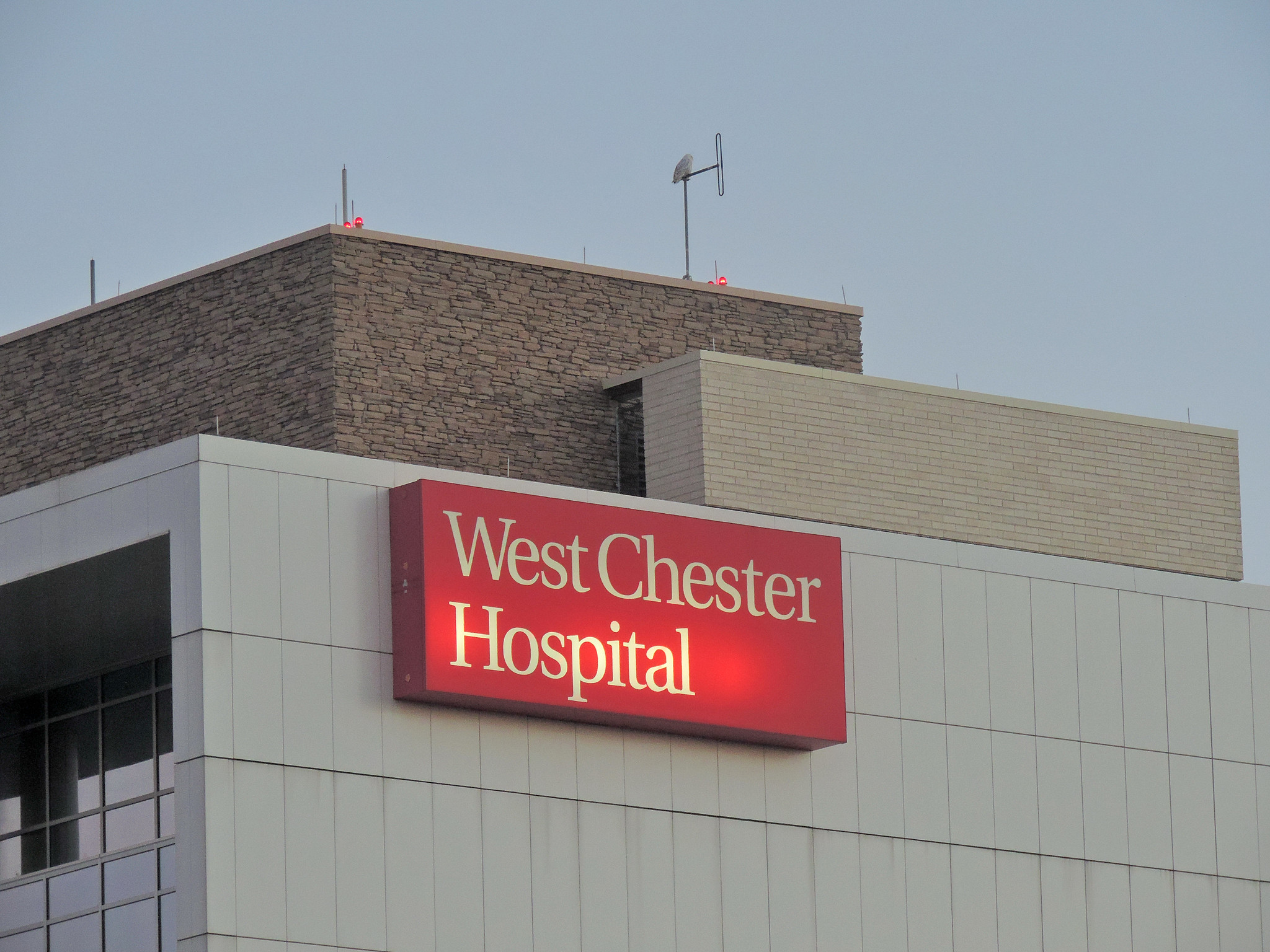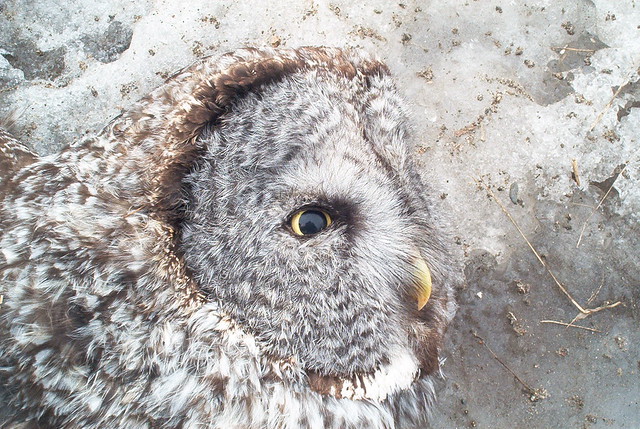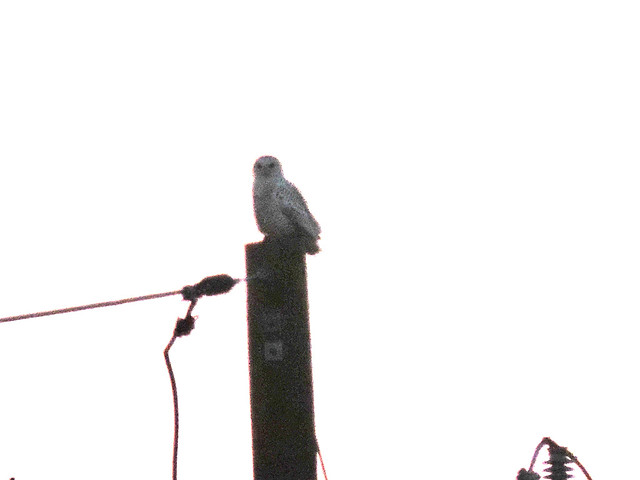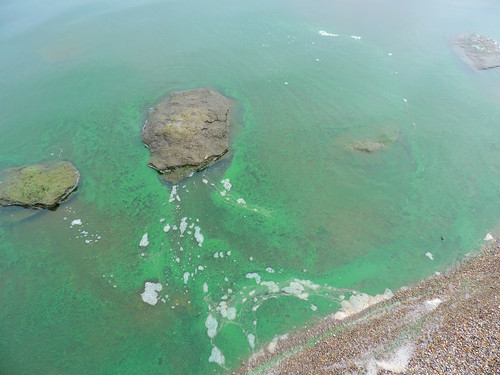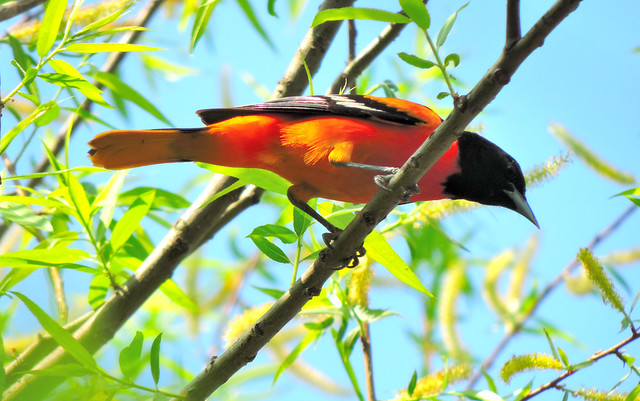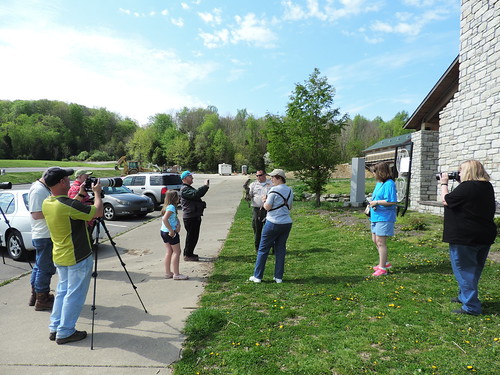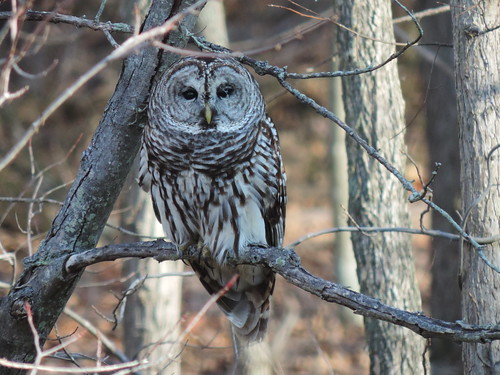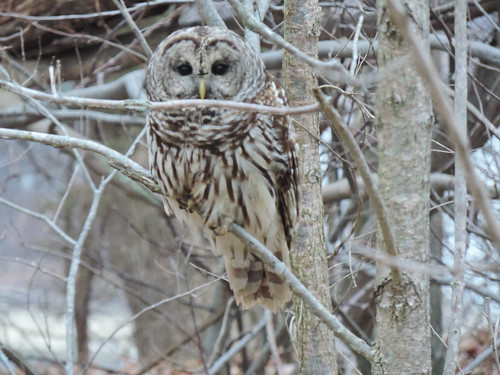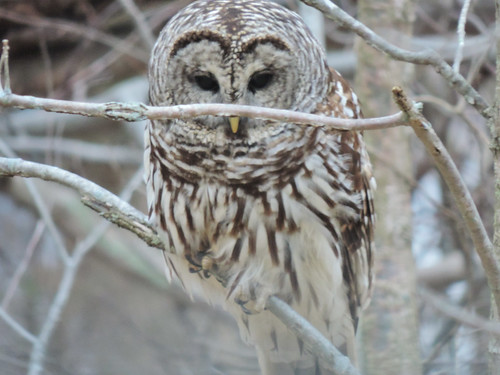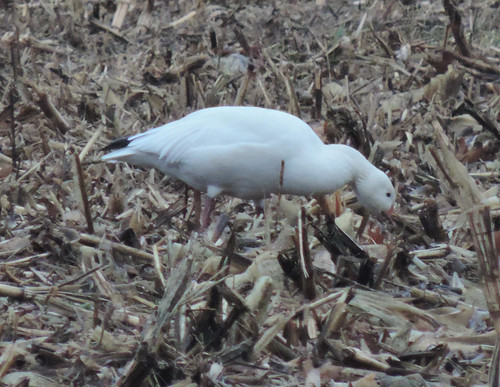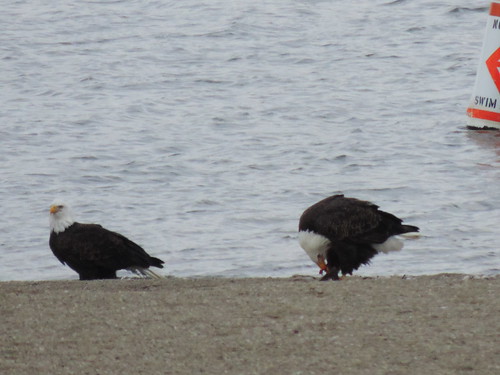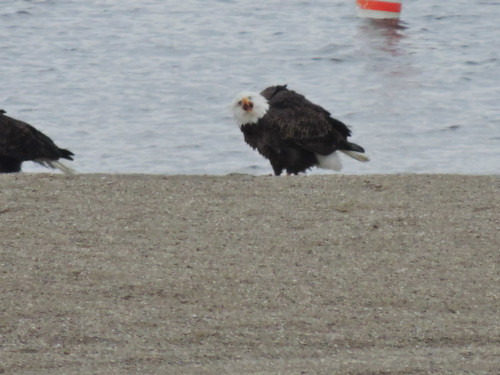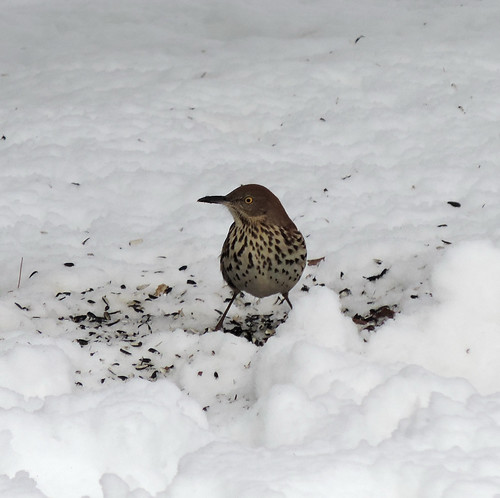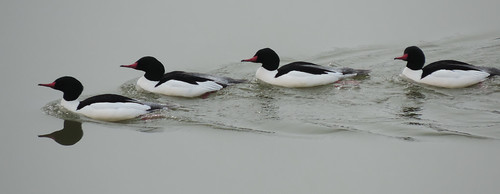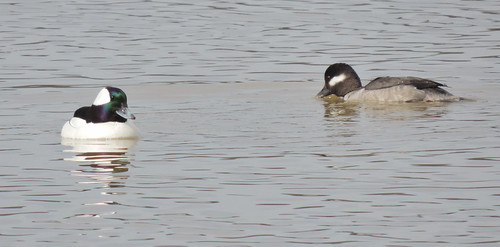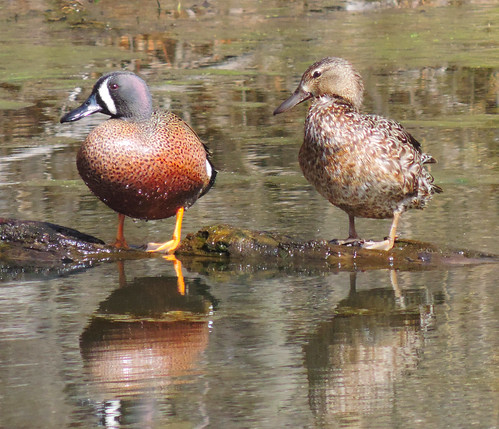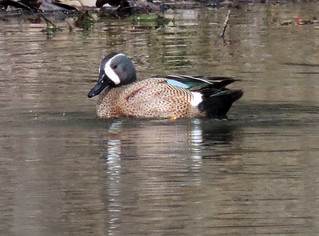Last Friday, a birder and employee of Voice Of America (VOA) Park in West Chester, OH. found and photographed a Snowy Owl in the park. It was later posted to Facebook, and as is to be expected, drew a lot of interest by tristate birders.
West Chester is a very, very busy area. It is exploding with development. This being said, the owl was in a dangerous area...
I have only seen one Snowy Owl in my lifetime and my girlfriend has never seen one. So, we went to check it out Saturday. As you can see, I was a loooong way from the bird...
First, let me say that I haven't been in the area or to the VOA park in a long time. When I first went there shortly after it was opened to the public, I was amazed that such a vast open area still existed in such a bustling place. I seen Bobolinks for the first time on a Birdathon there. I also got my lifer Henslow's Sparrow and Dickcissel there. These are birds that require extensive grasslands to breed. The Dickcissel and Bobolink tend to like similar, taller, vegetation while the Henslow's tend to like shorter grasses. Short-eared Owls were also seen there early on in the parks history.
Every time that I went there since, even just a few years later, I was shocked by the explosion of development. Not just around the park, but also IN the park. The area was designated an Important Bird Area by the Audubon Society. It is an important bird area, but like other parks with the same designation, it is seen as a minor annoyance to those with $$'s in their eyes. It actually holds little to no weight to stop such things. From what I heard, Bobolinks are still holding on barely in the park. More development is planned for the park according to the link below to Butler County Metroparks:
VOA
So what does all this have to do with the Snowy Owl? Let me explain. Many birders went to chase the snowy at VOA. It was moving around a lot. There were already early reports of birders getting too close, causing the bird to keep moving. An early report that I read stated that a birder chased the bird out of the park.
Many birders who were unfamiliar with the area, responded to the park thinking the bird was still there. I will be honest, if I was from out of town and didn't know otherwise or see a sign that said park, I would of not known that it was one. It is developed as much as the surrounding area near the entrance to the park.
I have seen photos of crows harassing the owl inside of VOA. This very well could of drove the bird out of the park. Here is my theory and opinion as to why the bird left the park.
The Snowy Owl likely took to the busy interstate to hunt not because of pressure from birders or photographers, but likely because the grass height was just right and the pavement made for a higher density of meadow voles/mice being there. Think of this analogy: If I was to fill both an Olympic size swimming pool and a plastic kiddie pool with 50 live mice and told you to catch one, wouldn't it be easier to catch one in the kiddie pool?
Other raptors also hunt near highways. How many Red-tailed Hawks have you seen sitting on the side of the highway only to swoop down on something in the median, just missing passing cars?
I went to Northern Minnesota during the owl invasion of 2005. I saw 30+ Great Gray Owls. I saw many Great Gray Owls feeding on the sides of roads. They were feeding during the day. This area was very rural, not many buildings at all. The birds had a lot of open land/wooded land. Many of them had just missed getting hit by vehicles. There were also a few dead owls on the sides of the roads. Very sad sight indeed. And guess what? NO other birders/photographers were anywhere to be seen. Here is a picture I took of one of the owls that got hit. It was DOA before we pulled up to it.
My point is that raptors, including owls, like to hunt on the sides of highways. We humans are a sloppy species and the rodent population is likely higher in these areas.
Here is my recollection of what I observed Sunday evening.
I had just arrived late Sunday (~5:15pm) to try to get better looks at the Snowy Owl. When I arrived, the owl just flew from the wall that was parallel to I-75. I saw birders parked in the middle of the road in the housing development. I also saw birders up on the hill by the wall that would of been fairly close to the bird. I did NOT see the bird on the wall, so I could not tell how close anyone was. As the lighting was fading fast, many birders left at this time. I could see that the bird flew across I-75. I then went over on the VOA side of I-75. I turned into a church parking lot off of Cox Rd. I could see the owl on top of a utility pole by the church. I stopped and did not go any farther. I had people behind me trying to get into the church parking lot. This made it to where I had to turn around, which put me closer to the owl. I stayed in my car and attempted to turn around in the lot at the church. A family of church patrons parked next to my car and a younger child got out of the car screaming and running around the lot. The owl had its back turned to me and the child the whole time. The owl was focused on something in the median of the highway (I-75). The owl flew down, barely missing a collision with vehicles. The owl then landed on a utility pole on the other side of I-75. It was still looking at something in the median area of I-75. I was able to get this pic of the owl, likely the last photo of the owl alive. This was taken from the church parking lot ACROSS I-75.
The owl flew from this pole, not to be seen alive again. It was too dark at this point to find the bird. I was on the other side (VOA) side of 75 when the bird flew from this pole.
The bird was actively trying to hunt, as was obvious. Research shows that they hunt mostly at night. Not long before this above picture was taken, I had run into someone I have known for a long while that was also there. This person is an experienced, Federally Licensed raptor bander. We both agreed that the bird was not stressed and I was told the bird just cast a pellet before I got there.
There is no birder or photographer to blame in the death of this bird. It was seen Sunday actively hunting, defecating, and ejecting a pellet. The latter means the bird was eating. The owl was struck at night most likely going after prey. The bird's carcass was found north of were I last saw the bird. Unless someone had a night vision camera, there were no birders present after dark. By publicly shaming birders/photographers, we are doing more harm to birds than good. This turns many people off to birding. In these times that we are in, we cannot afford to let this happen. Birds are facing continued threats to their existence from us humans. Be it automobiles, outdoor cats, pollution, wind farms trying to weaken federal bird protection laws for $, loss of habitat etc., the birds need as many people on their side as they can get. This will not happen with what I have observed on social media.
We need to be educators. Yes, the bird's well being is important and should be the top most priority when birding/photographing birds. A good bird photographer will learn how to tell when they are too close to a bird. The birds give you signs. Us experienced birders need to show newer birders/photographers how to recognize these signs.
Here is a wonderful infographic from Black Swamp Bird Observatory in Northern Ohio about how to watch a Snowy Owl safely.
Here are some take aways from the whole situation that I feel we must learn from and/or try to prevent from happening in the future.
- The area that this bird was in is a very dangerous stretch of highway. I have heard of people parking on the interstate and getting out of their cars to get close to the owl. This is illegal and dangerous. If the police would of showed, it likely would not be good for the owl or the birders. In these times that we are in, if a situation would have arisen where rush hour traffic was being impeded by suspicious people with binos, scopes and cameras, I feel that people could get arrested and charged with inducing panic and or something worse. I could also see the police shooting the owl to mediate the problem ASAP. Think this is over the top? Think again. Read these articles about what happened when Snowy Owls started stopping the $ wheels at airports:
Snowy Owls Shot Down at Airport
Ford Airport staff shot 9 snowy owls in last two months, live traps now set - Any area outside of the VOA park besides the roads and sidewalks that people were on was likely private property. The hill by the wall may have been a state right of way, but I don't know. The point here is that if someone was to call the law on someone for getting too close to the owl, the results could be the opposite of what you would expect. I could see a situation where people are feuding over how close someone is to an owl and since they are on private property, the involved parties of birders get charged with trespassing by the landowner who wants no part in the ordeal.
- Miscommunication. In these times of social media, information spreads fast. When the owl was first discovered deceased on the side of the road by birders, rumors started flying around the internet as to what had happened to the specimen. It is the state game warden's job to see that the specimen did not fall into the hands of people who would illegally possess it. Being hunting season, I am sure it would of taken a looong time for him to get to the scene. And, likely due to budget cuts, there is no non-game wildlife biologist at the state level in this district (state?) that I know of. For the future I suggest that if a Snowy Owl is discovered locally, even if it has no signs of distress, the county wildlife officer should be contacted and advised of its location as soon as possible. That way if a problem arises, he/she is not caught off guard.
Here are my final thoughts on the Snowy Owl saga. For those that feel helpless and want to help conserve and learn more about Snowy Owls, I suggest supporting those organizations that are working directly with them.
Project Snowstorm is a project that attaches GPS radio transmitters to the owls to learn more about them. What they are learning will help scientists understand and be able to conserve them better. The video below is a little introduction to the project.
Black Swamp Bird Observatory, who partners with Project Snowstorm, is well known by local birders for the Biggest Week In American Birding. They are very active in conservation on a national scale.
Raptor Inc. is our local raptor rescue and rehabilitation organization. They provide educational programs and medical care to raptors that need it.
We birders must not become our or the birds' worst enemies. What I mean by this is, no one is to blame in the death of the West Chester Snowy Owl. Do we blame the person who hit it? Whoever hit it probably was on their way to work and didn't even know they did. It could of been hit by a semi. If we must blame someone to make us feel better, we can only blame ourselves. We humans are the ones that are destroying habitat on a daily basis. The Snowy Owl just happened to migrate to an area that has some of the most explosive development in SW Ohio. The owls don't have Google Maps to be able to search for the best locations to go to. They are hard wired to go south when food is scarce and just end up somewhere. They will hang in an area where the food is most plentiful.
I feel that our local conservation/birding organizations need to quit being run like a Fortune 500 company and focus on these issues that undermine their missions. In this age of the internet and digital photography, it is even more important. Let me explain. Some people are more interested in getting published in magazines or ending up on the cover of the latest issue of the state birding record publication than getting to see the bird itself. Most birders/photographers I know are true birders, and concentrate more on the experience of birding and enjoy watching the birds. They take photos to relive the experience of the day. There is nothing wrong with wanting or having your pictures published. But if your only goal of getting out to see a bird is with hopes of making money or getting on the cover of the next issue of the bird records publications, then maybe you should just step back and take it all in. It will improve your experience and hence your pictures!
Better communication between NGO's, ODNR, and local government run parks is crucial. This is also where politics comes into play. The Division of Wildlife has been gutted by budget cuts. As far as I know, there is no non-game wildlife biologist in this district. There used to be a wildlife education specialist in district 5 (SW OH). This could of helped out in this situation if the wildlife education specialist was on the scene and could radio to the game warden in the case of a problem. Local law enforcement and even county park rangers most likely have no biological sciences degree or any knowledge whatsoever of birds. Even the recovery of the specimen became a social media circus. Rumors swirled that the bird was picked up by well meaning birders. Some said that it was picked up by Butler Co. Metroparks employees, however the Butler Co. Wildlife Officer had no knowledge of it. Most of the people concerned with the bird's postmortem placement were from NGOs and/or institutions outside of the Cincinnati area. Our local organizations were dead quiet. This looked real bad on social media, but this is the reality of the state that we have let our local non-profit science based organizations in Cincinnati become. Again, budget cuts, lack of funding, the running of non-profits as a Fortune 500 company are undermining bird conservation.
Update: Here is a link to a statement from Raptor, Inc. with more details about the Snowy Owl. Must have a Facebook account.
*Disclaimer: The thoughts and opinions that I present on this blog are my own and do not represent any organization or group*
Tweet
